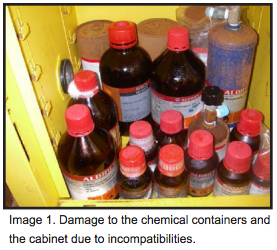In this multi-part series, we will discuss common problems with storage of chemicals in Emory research labs, and some practical solutions.
Background
Through the lab safety self inspection process, we have encouraged lab personnel to use secondary containers for corrosives and we now find acids and bases are stored this way. However, follow up lab safety inspections indicate that corrosives are stored in spaces not intended for corrosives, and are not stored by compatibility (Image 1).
Identifying what you have…
There are numerous resources available online to help you identify what types of corrosives you have in the lab, and their known incompatibilities.
- A chemical compatibility list is also available from the Emory EHSO by request.
- A useful external source from the University of California, San Diego (UCSD) has an extensive chemical compatibility guide that defines different corrosives types and describes acceptable storage practices (see blue box).
- Chemical manufacturers and suppliers have guidance material as well as safety data sheets (SDSs).
…and where to put it
- It is best not to store acids in the flammables cabinet. Acids will corrode the metal in the flammables cabinet. The corrosives cabinet under your chemical fume hood is the best place to store acids. It is either lined with low density polyethylene (LDPE) or with particle board and epoxy resin.
- Use secondary containers to store your corrosives.
- Separate incompatible acids into individual secondary containers.
- Bases are placed in secondary containers and stored in a dedicated wooden cabinet, or in an corrosives cabinet. Acids and bases should not be stored in the same corrosives cabinet, even if separated by secondary containers. A salt will form on the outside of the containers when stored together.
Further Recommendations (in order of increasing feasibility)
- Obtain stand-alone corrosive cabinets for each category of corrosives in the lab.
- Purchase low (dilute) concentrations of corrosives whenever possible, or purchase the minimum amount of concentrated corrosives needed.
- Work with neighboring labs with corrosives cabinets to combine and store compatible corrosives across multiple spaces.
- For proper storage of corrosives, you may need to visit and cross-reference several resources to get the best answer. As always, EHSO can help you along the way, so please ask us!
Visit USCD’s chemical compatibility page for access to their extensive chemical compatibility guide.

